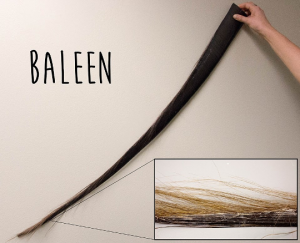By Emma Goldberg
When you get hungry, the fridge or the pantry is only steps away. Whales, however, are not so lucky. Weighing between 8,000-300,000+ pounds, these ocean giants don’t have the luxury of storing all of their food in one spot. Instead, different species of whales have developed creative and cool ways to catch their prey!
When it comes to how whales eat, much of their techniques depend upon what’s inside their mouths. Killer whales, for example, have mouths filled with 4-inch long teeth that help them eat large fish and other marine mammals. Other whales, like humpbacks and bowheads, have mouths filled with a substance called baleen, which is made of keratin – the same material that makes up your hair and fingernails. Each baleen whale has several hundred plates of baleen in his or her mouth, each placed about ¼ inch apart from each other. The plates are smooth on the outer edge and have a hairy, fringe like end to them–kind of like the bristles on a hair brush.
But not all baleen whales are alike. The 15 species can be further divided into four families, each of which has evolved a distinctive feeding pattern.
Humpback whales belong to the rorqual family of baleen whales. Rorqual whales have special folds in their throats that help them open their mouths wider than they would be able to otherwise. Once their mouths are open, they engage in what scientists call “lunge feeding,” where they quickly ram into a school of fish and take in as many as they can. Lunge feeding is effective, and whales can catch a lot of food this way. Unfortunately, lunge feeding requires a l lot of energy and makes the whales tired. Not to worry though, because whales are smart and have learned other ways to catch food efficiently.
One of these techniques is known as pectoral herding, or “bubble-netting.” University of Hawaii researchers recently observed humpback whales and recorded this feeding activity in the cold waters of Alaska. This type of feeding has only been observed in Alaska and only several hundred humpback whales know how to do it. Using a drone and an accelerometer, the researchers hope to better understand how humpback whales form and use their bubble nets. The video below from BBC shows whale bubble-netting in action!
This data was collected very recently and we’re still learning from it. So far, we know that bubble-netting is a team effort. One whale, the leader, will blow a circle of bubbles around a group of prey fish, such as herring. This creates a “net” in the water, trapping the fish inside. A second whale then calls out to the group, letting them know it’s time to act. The group of whales works together to get the fish tightly packed inside the net. When it’s time to eat, the whales turn slightly onto their sides and use their throat folds to open their mouths and get a huge gulp of fish. Using bubble nets, the whales are able to get a large amount of food without using a lot of energy. There’s still a lot to learn about the feeding behavior of these large ocean dwelling mammals, and researchers are hopeful that the more knowledge we have, the better we can protect them!
Edited by Anna Wheless and Zoe Terwilliger

